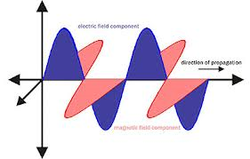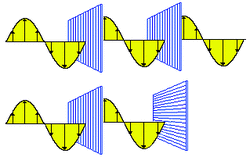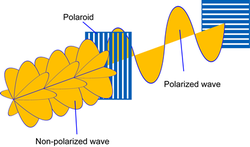Light and all electromagnetic waves can vibrate in many directions. Those that are vibrating in one
direction -- in a single plane such as up and down -- are called polarized light. Those that are vibrating in more than one direction -- in more than one plane such as both up/down and left/right -- are called unpolarized light.
Generally, unpolarized light can be considered to be vibrating in a vertical and a horizontal plane. To polarize light, one can transmit the light through a polariod filter which will only allow light of single polarity to pass. The
resulting light will be polarized light of half intensity. If two polaroid filters are used and placed so that one is rotated 90 degrees to the other, no light will be able to pass.
Some polarization will also occur during reflection, refraction, and scattering of light. When reflecting off non-metallic surfaces, the resulting light will be polarized parallel to the reflected surface. During refraction, a beam of light will be split up into two polarized beams, one polarized parallel and one perpendicular to the boundary. Scattering also causes partial polarization.
direction -- in a single plane such as up and down -- are called polarized light. Those that are vibrating in more than one direction -- in more than one plane such as both up/down and left/right -- are called unpolarized light.
Generally, unpolarized light can be considered to be vibrating in a vertical and a horizontal plane. To polarize light, one can transmit the light through a polariod filter which will only allow light of single polarity to pass. The
resulting light will be polarized light of half intensity. If two polaroid filters are used and placed so that one is rotated 90 degrees to the other, no light will be able to pass.
Some polarization will also occur during reflection, refraction, and scattering of light. When reflecting off non-metallic surfaces, the resulting light will be polarized parallel to the reflected surface. During refraction, a beam of light will be split up into two polarized beams, one polarized parallel and one perpendicular to the boundary. Scattering also causes partial polarization.



 RSS Feed
RSS Feed